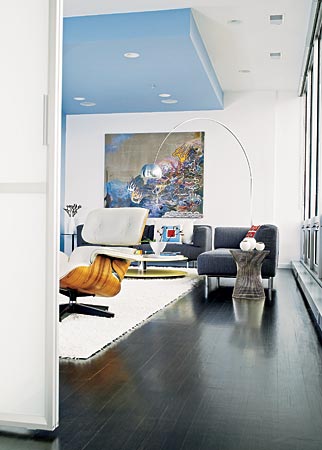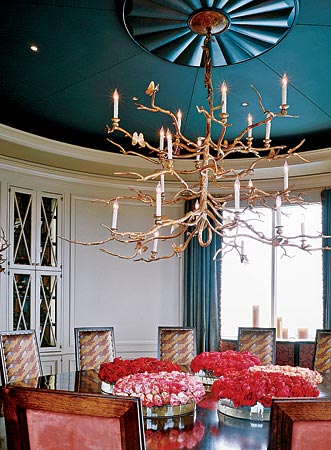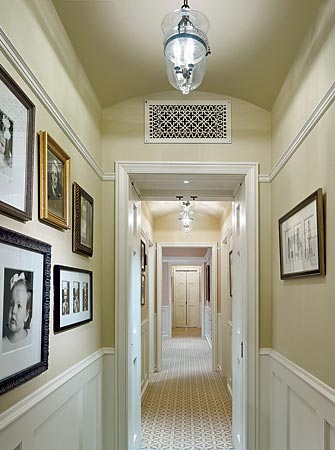A: Ceilings might be the most frequently overlooked visual element of any home. As architect and interior designer Eric Mullendore (2943 N. Seminary Ave., 773-477-7002) says, “It’s a whole other plane in the room. After all, you wouldn’t ignore the floor.” He thinks people default to white without always considering other options. “A little bit of color draws your eye upward and expands your vision of the room.”
“A little bit” sounds safe, but what color? Painting the ceiling a lighter shade of the wall color produces a unified look and is a tried-and-true way to go. Designers suggest anything from the faintest tint to using as much as one-half the tone of the walls. Most recommend a flat finish, rather than one with a sheen, which draws attention to imperfections. There are exceptions to that rule (assuming your ceiling is in pristine condition), such as when you want the ceiling to have a reflective surface.
The reason most people go lighter is that ceilings naturally appear darker than walls anyway, so the wall shade would look darker up there, and visually lower the ceiling, says interior designer Gail Smith, (Taradash/Smith Design, 3359-A N. Ridge Ave., Arlington Heights, 847-590-0490, taradashsmith.com). She adds that the lower the ceiling actually is, the darker it will look. Which isn’t to say you don’t ever want a dark ceiling—it can work very well in a powder room or a dining room, where a little drama is in order. It depends on the mood you’re trying to achieve.
A classic ceiling color is blue, which interior designer Dale Carol Anderson (2030 N. Magnolia Ave., 773-348-5200, dalecarolandersonltd.com) says makes the ceiling appear higher because of “a psychological connection to sky.” You can use this trick with almost any wall color, from a sedate off-white to a saturated red. Anderson recommends pale shades such as robin’s egg up there; a blue she particularly likes is Farrow & Ball’s Pale Powder.
If you want to paint your ceiling a more vibrant color, many professionals will back you up. Interior designer Erin Shakoor (Shakoor Interiors, 1071 W. 15th St., 312-829-7126, shakoorinc.com) likes the idea of actually seeing the ceiling when you enter a room. “Paint it a more noticeable color!” she says. “Ceilings are just as important as walls. They are a natural extension of the room.” She has created some dynamically rich palettes for walls and ceilings and often adds textural interest to ceilings with molding and wallpaper.
White has its place, though. “There are two reasons to paint a ceiling white,” says interior designer Kristen Larkin (Smith & Larkin Interior Design, 432 N. Clark St., 312-527-5501, smithandlarkin.com). “Imperfections in the ceiling will show more if you use a color, and if you have a low ceiling, a darker color will make it seem even lower and you’ll feel squished.”
We would add a third reason. Paint your ceilings white if you like white ceilings. Interior decorator Laura Soskin (847-525-9955, laurasoskindesign.com), loves them. “I believe that painting a ceiling white opens up the space and gives your eye a place to rest,” she says. “It’s peaceful for the eye and mind.”

1 Sky-blue paint overhead helps to define a seating area in a high-rise condo designed by Patrizio Fradiani of Studio F Design.

2 Deep color (Farrow & Ball’s Down Pipe) provides a dramatic backdrop for a chandelier and creates a sense of intimacy in a large dining room designed by Jessica Lagrange Interiors for a Lake Shore Drive residence.

3 Having the same color on walls and ceiling gives this hallway in a Winnetka home, designed by Gary Beyerl and Kristin Fogarty of Burns & Beyerl, a unified look.
Photography: (1) Andreas Larsson; (2,3) Nathan Kirkman


